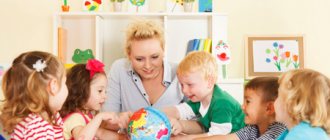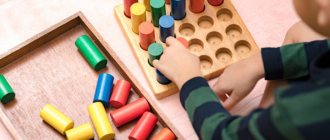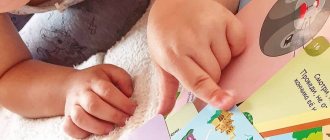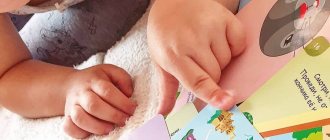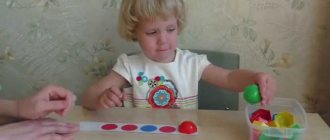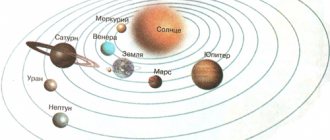Developmental activities for children from 1 to 3 years old - are they necessary and how to organize them correctly? Difference between early development and learning.
Modern parents begin to think about activities with their baby early. Why is this happening? After all, just a few decades ago it was believed that children under three years old just needed to be loved, and their studies could wait. And how to deal with such a baby - what does he understand, he hasn’t even learned to speak properly yet!
Some people continue to hold this point of view today. Surely some kind grandmother - your own or a neighbor's - advises you “not to pester the child”, to leave the baby alone: the main thing is that he eats well, sleeps soundly, is cheerful and healthy!
Of course, feeling great and in a good mood is great. But is this wonderful set enough for modern children and their parents? Why today do we increasingly hear the words “early development” from parents and specialists? Why are early development centers opening everywhere, offering educational activities for the little ones, new methods of developing children being created, excellent books and developmental manuals being published for children from 1 to 3 years old?
Progress does not stand still. Modern science proves the importance of child brain development at an early age (up to three years). This statement implies the following: the more useful knowledge, skills and abilities a child masters at this age, the more firmly they will be consolidated and will serve him for the rest of his life.
In other words: if you want to realize the child’s natural potential, do not delay his education and organize developmental activities!
You probably want to help your child speak faster, give him all the necessary and varied knowledge about the world around him, teach him to think, and develop creativity. In this case, the child will not only keep up with his peers, but will successfully realize the full potential given to him from birth. But how to achieve this?
To fully develop, a child needs the help of an adult. Today it turns out that it is not enough just to talk a lot with the child, play with him and read books together. Unfortunately, often due to the lack of experience and necessary knowledge among the child’s loved ones, it is not always possible to achieve significant results during classes.
How to develop a child? At what age do you start training? How and what to teach a child? What is useful and relevant for a small child, and what should patiently wait its turn? You need to work with your child correctly!
After all, if you offer a child a task that is too difficult and does not correspond to his age capabilities, he has no chance to cope with it. As a result, the child loses interest in continuing the activity, and adults conclude that the child does not like such activities or is not yet ready for them.
If, on the contrary, it is too easy to offer the child something very simple, which is given to him without tension, it will also not bring any benefit and will not move development forward.
However, with an adequate selection of tasks, great opportunities for the child’s development appear. There are modern progressive techniques that allow you to organize activities with children in the most effective way!
Early development methods specially developed for the youngest children allow them to teach new knowledge, skills and abilities quickly, simply and cheerfully and, of course, in an exciting game!
Your task is to interest the baby. By completing simple and exciting tasks with your child, you realize the possibilities of early development, creating the necessary foundation of knowledge - the foundation of the child’s entire future education.
About the early development of children
WHAT is early development? Not everyone knows this and sometimes confuses it with early learning. In this case, adults strive to introduce the child to letters and numbers at an early age, teach him to read and count, and begin learning a foreign language. And they wonder why their child not only does not experience joy and enthusiasm from such activities, but begins to resist, trying with all his might to avoid such difficult and unnecessary lessons for him.
Early development is the organization of systematic developmental activities with a child aged 1-3 years in different areas.
At the same time, the content of training, the structure of the lesson and the features of its implementation correspond to the psychological characteristics of an early age. Let us recall that the term “early development” is applicable for ages from 1 to 3 years, that is, before the child enters kindergarten.
This approach corresponds to the age classification adopted in Russian psychological science: up to 1 year - the period of infancy; from 1 year to 3 years - early age; from 3 years to 7 years (before entering school) - preschool age.
At an early age, the task of the child’s loved ones is to create a favorable situation for the child’s development. As they say, “there is a time for everything” - there are wonderful techniques, toys, books that are relevant and unusually effective during this particular period of time.
And this does not at all mean that the child must be constantly dealt with, and the house must be littered with educational aids. It’s better when everything is in moderation and the baby has time for classes and free activities, and, of course, to communicate with loved ones.
But before starting classes, it is useful to list the psychological characteristics of early childhood. This knowledge will help when teaching a child to act in the most appropriate and effective way, because as a result there is a better understanding of the baby, his capabilities and needs.
Subject activity of a young child
The first objects (rattles, tumblers, etc.) appear in a child’s life already in infancy (up to one year). However, in the second year of life, the baby is completely captivated by the objective world!
Subject-based practical activity is associated with the mastery of socially developed ways of acting with objects. It becomes the leader at this age and determines the development of almost all mental processes and the child’s personality as a whole.
One of the tasks of an adult at this stage is to provide the child with a developing subject environment.
Early Cognitive Development
Among all mental processes, the main role at an early age belongs to perception. Moreover, perception throughout early childhood is closely related to objective actions.
First, the child perceives the shape and size of objects; orientation to color appears later. From actions with objects, the baby gradually moves to visual perception, which contributes to the formation of images and ideas.
Kids actively use visual and effective thinking to discover a wide variety of connections between things and phenomena in the objective world around them.
Speech development at an early age
Early age is a period of rapid development of a child’s speech. Speech arises and initially develops as a means of communication with adults. In the future, it becomes a means of thinking and a means of mastering one’s behavior.
The beginning of the second year of life is the period of autonomous child speech. The words of a child of this age differ from adult words both in sound and meaning. They are inextricably linked with the perceived situation and perform mainly an index function.
In the middle of the second year of life, a “speech explosion” occurs: the child’s vocabulary increases sharply, and the child’s interest in speech increases. In the third year, the development of the grammatical structure of the language begins - phrases (sentences) appear, from simple ones (2-3 words) they gradually become more developed.
Development of play at an early age
At the beginning of the second year of life, a toy acts for a child as an ordinary object that can be manipulated: the baby moves toys from place to place, knocks them, puts them in various containers, that is, carries out non-specific actions with them. Later, play is separated from objective-practical actions and becomes a specific activity of the child.
Gradually, during the second year of life, children learn the playful purpose of objects: they begin to feed the doll, put it to sleep, knock with a hammer, etc. The content of play actions is imitation of an adult - the baby does not invent anything new, he only reproduces on different toys what is already I did it with an adult.
During the game, the baby can repeat the same action with a toy many times or perform several actions without a logical connection (for example, feeds the doll, combs his hair, puts him to bed, combs his hair again and feeds him again, etc.).
At the end of early childhood, symbolic play substitutions appear: some objects begin to turn into others for the child and replace those that are missing. This opens up space for the child’s imagination and frees him from the pressure of the existing situation.
Development of communication at an early age
Situational business communication with an adult becomes a form and means of organizing the child’s objective activity. At the same time, an adult is not just a source of objects and an assistant in the child’s manipulations, but also a participant in his activities and a role model.
At an early age, the need to communicate with other children arises. The decisive role in the process of forming communication with peers belongs to the adult who organizes a joint game. But only after three years do children independently demonstrate a pronounced need to communicate with peers and specific forms of interaction with each other.
Prerequisites for personality development and the three-year crisis
At an early age, a child has a very special attitude to reality. Perception and emotions are not separate from each other and represent an inextricable unity that causes immediate action in a situation.
It is the attractive power of things, the affective charge of each thing that conceals the source of attraction for the child. Thus, throughout early childhood, the child’s behavior is situational, depending on what is happening here and now, but by the age of three this feature is gradually overcome.
Towards the end of early childhood, this finds expression in the words “I myself,” which are evidence of the crisis of three years. The child’s desire for independence and independence from adults, both in actions and desires, sharply increases. This leads to significant complications in the relationship between a child and an adult and is manifested by such symptoms as negativism, stubbornness, obstinacy and self-will.
The child is psychologically separated from close adults with whom he was previously inextricably linked, and is opposed to them in everything. The child’s own “I” is separated from adults. The formation of the “I” system and self-esteem marks the transition to a new stage of development - preschool childhood.
Topics of notes:
September
1. Meeting of friends 2. Learning to be friends 3. Hello, windy breeze 4. Breeze and rain 5. Orchard 6. Vitamin boost 7. Gifts from the village 8. What grows in the garden
October
9. Who lives on the farm 10. Domestic animals and their babies 11. The chicken is looking for its mother 12. The chicken and the duckling 13. Lost supplies 14. Forest animals 15. Trees 16. Trees. Miraculous transformations
November
17. Wild birds 18. Birds in the city 19. Matryoshka 20. Favorite toys 21. Box of pencils 22. Magic paints 23. Pyramid 24. Ball
December
25. Fun tea party 26. Dishes 27. What’s for lunch today 28. Edible and inedible 29. This is Africa! 30. Elephants and giraffes 31. Visit the penguins! 32. Polar bears
January
33. White in winter, gray in summer 34. Teddy bear 35. House 36. Everyone in the world needs a house 37. Long live scented soap 38. Good Doctor Aibolit 39. Big and small 40. Hot and cold
February
41. Round-square 42. Day and night 43. Clothing 44. Clothing 45. Shoes 46. Generalization. Shoes and clothes 47. Dad's helpers 48. Watches
March
49. Helping mom 50. Grandma visiting 51. Household appliances 52. Where the sparrow dined 53. Elephant’s birthday 54. Let’s go to the theater 55. Telephone 56. Rainbow
April
57. Sea trip 58. Fish 59. Furniture 60. Furniture 61. Shopping 62. I love my horse 63. Such different cars 64. Train
May
65. Air travel 66. Transport. Generalization 67. Flowers 68. Ladybug 69. Butterflies 70. Ant 71. Bee 72. Frog
June
73. Snail 74. Turtle 75. On a forest path 76. Dandelions 77. Water Sorceress 78. Kittens and gloves 79. Magician 80. Dunno visiting a baby
Early Child Development Concept
When working with a child, an adult must understand well what he is doing and why. Even with the most advanced early development techniques, the results will be limited if we do not understand the ultimate goal of our efforts.
The goal of a child’s early development is not at all to fill him with as much new information as possible.
A large amount of information does not at all give a child a unique chance to develop his brain to the fullest and gain that very strategic advantage of human consciousness, which no living creature except humans has.
The ultimate goal that parents of children set, albeit not always consciously, is to increase the child’s chances of becoming happy. And the idea of happiness in the modern world is success, competence, and self-realization in society.
It is very important to realize this veiled goal - in this case, you can provide the baby with the best situation for development.
How to create a developmental environment for a child and organize developmental activities?
It is necessary to give the child a picture of the world around him . This means that the baby must be provided with sufficient quantity and quality of information about the world around him. It is important not just to give scattered information, but to create a “university for kids” (it was on this principle that Soviet education was built, which was not without reason at one time recognized as the best in the world).
Information for training must be clearly selected, verified in its volume and quality, and must give an idea about the main aspects of people’s lives, about living and inanimate nature.
This also includes the other side of the issue: we live in the age of information technology and the amount of information surrounding each person is enormous. In order for the baby to develop harmoniously, you will have to spend a sufficient amount of time and effort to prevent harmful, unnatural, scary or immoral information from influencing the child’s consciousness.
The main task of parents is to gradually, but regularly tell and show their child interesting and entertaining things about the world around them.
Information about the world around must be clearly structured, differentiated and systematized . Only in this case “the puzzle will be completed” and a clear and understandable picture of the world will be formed in the child’s mind, which will help him in life.
Another analogy can be drawn. Imagine that a child’s education (the process of accumulating knowledge, skills, abilities) is the creation of a library, where books are knowledge and skills, and the child’s brain and memory are the library premises. So, you can dump books in a heap in the middle of the room. The knowledge itself remains valuable and useful, but using it when necessary becomes very difficult, if not impossible.
But you can do it differently: first build cabinets, racks and shelves, number and designate what will be on these shelves, and only then gradually place books of knowledge on them. In this case, the process of accumulating and using information is greatly facilitated; such information is not dead deposits - it is active and can be used at any time.
So, in my opinion, creating such a base, a foundation that can be built upon throughout the rest of your life, is one of the main tasks of a child’s early development. And it’s better to do everything right right away, so that you don’t have to redo and rebuild later.
Information about the world should be varied, voluminous, and diverse. We must keep in mind that information about the world has a different essence and nature: there is pure information, and there are material objects - this is the world of toys, objects, pictures.
The child should receive sufficient quantities of both. For example, you can’t just talk to your baby; our stories about the world must be supported. To do this, we show the baby pictures and videos, play with toys and objects, observe natural objects and objects created by human hands.
One of the main tools for understanding the world is speech . In order for various sensory information about the world, obtained through the senses (vision, hearing, touch, smell, taste), to gradually become ideas, it is necessary to designate them using words.
So, if we play with a child, it should not be silent manipulation of objects - the adult names objects and their signs, comments on the entire process of activity.
It is very important to learn how to speak correctly with a child: speech should be simple (short phrases), clear (do not contain contradictory information), brief (you don’t need to say a lot, speech and the information it carries must be dosed in accordance with the age of the child), conveyed information must be correct (information must be relevant and correspond to modern scientific ideas about the world).
Education must be continuous . This means that you need to work with your baby regularly - this is the main thing. At the same time, you should not strive to give as much knowledge as possible at this tender age: you need to study in moderation, not to overdo it, otherwise you can completely discourage the child from learning.
To build a child’s education system, you need to have a plan, namely, draw up a program for his development. This must be done competently, i.e., select only the material that is really necessary and is perfectly absorbed at this age, while strictly dosing its quantity.
After this, you need to calmly follow the plan, and the result will not be long in coming. In addition, continuity of education is necessary - a harmonious transition from an early age to preschool, and then to school, without contradictions in the content and method of presenting knowledge.
Visible learning results are not the main thing . It must be taken into account that not in all cases the results of a child’s education become immediately visible. Visible results, when a child can demonstrate his erudition and skill, are, of course, a pleasant bonus for parents for their efforts, but still not the main result of learning at an early age.
Our main task is to lay the right foundation of education, no more and no less. However, many parents cannot get rid of the habit of comparing their child and his level of knowledge with other children! In addition, many people want to demonstrate the success of their child. This is the wrong motive, distracting from the main goal of the child’s early development.
Without concept there is no good education . When developing and teaching a child, we must clearly understand and realize why we are doing all this. In order to develop a child, we ourselves, adults, must be able to “look at the world through a telescope and a microscope”: on the one hand, see details, imagine the content and principles of operation of individual components of the world, and on the other hand, be able to see the overall global picture.
In other words, we must “ think globally and act locally .” When teaching a small child, on the one hand, give him basic information, speak in simple words, pay attention to interesting details. On the other hand, keep in mind the main goal - laying the foundation of education. If you keep your focus, it is easier to go in the right direction and not go astray.
Perhaps someone will be surprised after reading these lines: why such difficulties, this is a small child, it’s easy to teach him. You need to teach your child correctly from the very beginning, and to do this you must first understand the goals and objectives of the child’s early development, and only then begin to achieve them.
Fine motor skills
For the development of fine motor skills in children 2 years old, large buttons, colored pasta, and sensory boxes, which we already discussed a little higher, are suitable. Give your child a string and a handful of colored pasta and show him how to make fancy beads if you have a girl and a bunch of gun cartridges if you have a boy.
Massage is perfect for finger development. Gently massage each finger in turn and play magpie-crow. Try to teach your child to fasten his own buttons as soon as possible. Speech therapists advise giving your child buckwheat mixed with rice or peas. It is not necessary for the child to do this for 20 minutes. 5-7 minutes is enough.
Games that develop fine motor skills:
- modeling with plasticine, clay, salt dough;
- It is useful to stick plasticine or paste onto stencils and drawings;
- appliques, working with scissors - an excellent simulator;
- games with clothespins, clamps;
- games with cereals, busy boards;
- putting together puzzles, sorting out magnets of different shapes on the refrigerator;
- The new magnetic construction set performed well.
Tip: How to color cereals or pasta? Dissolve food coloring in 3-6 ml of water in a container. Add cereal or pasta. Gently shake and scatter on a table covered with cling film or a bag to dry for 10 hours.
The more independent a child is, the less likely it is that a child will be developmentally delayed at 2 years of age. Allow him to do everything that is not dangerous to his health and well-being. If a baby climbs a hill, it is better to insure than to prohibit it. If he wants to help clean up, give him a broom or vacuum cleaner. If your hands reach for the food cupboard, pour a couple of handfuls of cereal into the container and tell them how to cook the porridge. Everything is important for finger motor skills: every movement trains the fingers in one way or another, develops muscles and tenacity.
Early Years Education
High level of learning ability . This is the most important opportunity for activities with your baby. The child’s brain is forming, it is very plastic. Therefore, it is during this age period that the child acquires knowledge faster and more effectively than in other age periods.
However, a child cannot acquire all knowledge, but only that which is available to him at this age. In addition, the very form of presenting new knowledge and skills should be adequate for an early age. The speed of passing new material should also correspond to the age and individual capabilities of the child: you need to set a certain pace for the lessons, but you should not rush too much.
Therefore, classes with a child require a thoughtful selection of tasks that are adequate in content and level of difficulty, as well as compliance with the rules for conducting classes with young children. Our book will help you achieve a balance between the opportunities and limitations that accompany a child’s age (second year of life).
Game component of early development . The leading activity of a young child is object-based play. When organizing activities with your baby, it is very important to remember this. After all, if you do not take into account this feature of young children, it is almost impossible to correctly organize developmental activities and achieve impressive results. Let us outline several rules for creating a developmental environment for a child aged 1–3 years.
The baby should have a sufficient number and variety of items to play with: from entertaining toys to educational ones. Of particular importance are multifunctional toys - those with which you can perform many different play actions (matryoshka dolls, inserts, colored cubes, etc.).
In addition to toys, the child should have the opportunity to use a wide variety of household items for play, such as dishes, storage containers, etc. The items with which the child plays must meet a number of requirements:
- safety (for example, do not use sharp, glass, or excessively heavy objects);
- environmental friendliness (items must be made from environmentally friendly materials,
- quality (items must be durable, easy to use);
- novelty (on the one hand, you need to give the child new objects, and on the other hand, do not forget to remove old boring objects and toys, temporarily replacing them with others).
The role of an adult in the early development of a child . In light of the above, one of the tasks of an adult is to provide the child with a subject environment and a constant influx of new interesting objects: select good toys, repair or remove broken ones from use, from time to time put away boring toys, which, upon returning to the child in a few months, will be acquired again. the quality of freshness and novelty.
But the main role of an adult in a child’s objective play is joint activity with the baby. It is necessary to clearly understand that if an adult does not become an active participant or organizer of the child’s object-based play, a real play partner, he will not be able to recognize and assimilate the basic function inherent in the object and the method of acting with it. No educational interactive toys can replace an adult playing with a child - neither in significance, nor in the power of influence, nor in the result of the game, which is ultimately expressed in the child’s level of development, his competence in the environment around him and the world in general (of course, at the level of his age).
The process of a child mastering human speech is also completely built on imitation of an adult: we are given this opportunity by nature - to master speech and learn to actively use it in society, but this can only happen thanks to the people around the child.
Never refuse your child when he asks you to play with him. Don’t forget how quickly time flies: most of our important adult affairs can wait, but a child won’t wait, he needs to explore the world and develop here and now!
Gifts of civilization for a baby . Before you begin developmental activities with your child, you need to answer the question for yourself: what is education? This is the transfer of human experience from generation to generation.
The experience of humanity accumulated over thousands of years is not transmitted genetically, but only through training. Therefore, it is impossible to become a civilized person without a good education. We can say that a child is born a small animal and without special training with the help of other people will not become a person - it will be a little Mowgli in the concrete jungle. Understanding this allows us to realize the seriousness and importance of the issue of development and education of children.
A specialist who constantly works with children can, at one glance, distinguish a child who is not being treated from one who is being treated. The first one has a lack of initiative (after all, he is already accustomed to not paying attention to him), a bored look (the child cannot organize himself, come up with an interesting game, does not know how to get involved in the game that is offered to him), simple manipulations with toys (twirls in hands, knocks, throws, but does not really play, because only an adult can teach this), field behavior (this means that visual images lead the baby: having grabbed one object, he throws it and runs after another that hits in sight).
Kids who are properly trained are completely different: such a kid is full of enthusiasm (he already knows that during the lesson there will be many interesting and exciting games), he is demanding (the kid has experience interacting with an adult and knows what the adult can do, so he asks him a toy, demands to play with him, etc.), he is active and proactive in his knowledge of the world. This condition of the child is, of course, more troublesome for the parents, but good for the child. He is interested in life!!!
There is also a third category of children - those with whom they work, but do it incorrectly, without taking into account the physiological and psychological characteristics of their age.
If a child’s development is based on the type of schooling, and not in play, if they try to teach a child to write, read and count ahead of time, you can completely discourage the child from studying and cause a persistent negative attitude towards learning.
In this case, you need to immediately stop torturing the child, because such study will be of no use anyway. And then offer properly structured activities that meet the needs of his age.
The importance of online games for children
You can study at home and on the computer. Another good option is an online educational program for kids. Children 2−4 years old will find it especially useful and interesting to study on a computer. But the main thing here is that their duration does not exceed 10-15 minutes. For example, tasks such as “find a pair” or “pick up an object.”
Additionally, you can offer games such as collecting pictures, coloring, putting together puzzles, finding extra objects , etc. Such games are not difficult for a 2-year-old child, but the brightness of computer animation is very addictive and interesting. In order for such games to actually be useful for a child, you need to practice with him constantly. It is important to be patient with the child, and this will bring huge benefits in his development.
Early development content
What is still worth teaching at an early age? Without deciding on the answer to this question, it is difficult to start learning without running the risk of making annoying mistakes. Therefore, this question should be decided in advance, and the answers to it should be clear and fully conscious.
When working with the smallest children, the main attention should be paid to the following areas of development:
- sensory development: study of objects and their significant features (color, shape, size, texture, etc.);
- speech development: the baby’s active speech (what the child says) and passive vocabulary (what the child understands);
- acquaintance with the surrounding world: objects, animals, people’s lives, etc.;
- development of movements and fine motor skills;
- creative activities: drawing, modeling, appliqué;
- introduction to mathematics;
- development of thinking,
- getting to know music,
- physical education,
- developing self-service skills.
Features of classes with a young child
When starting systematic lessons with a small child, we must clearly understand that they require a very special approach and cannot simply repeat learning at a school desk. This is not long sitting at a table, these are not leisurely detailed explanations, these are not complex written and oral tasks. In no case!
Classes with a small child differ in a number of features. The lesson takes place in a game and necessarily involves the use of objects and images as supports for perception.
The lesson can take place alternately on the floor (carpet) and at the table, it does not last long (usually 5–20 minutes, in the third year of life - 20–30 minutes or more) and ends at the moment when the child shows the first signs of fatigue.
The child’s results are not evaluated, but praise for the efforts made by the child is necessary (be careful: it is dangerous to over-praise the child!). The best form of classes is a complex lesson, when types of activities replace each other. At the same time, the adult comments on the entire course of the lesson.
Thus, we organize systematic classes, based primarily on the needs of the child, creating for him a comfortable development situation that satisfies his desire for new knowledge. A properly structured learning process supports and stimulates the child’s interest, and only in this case does learning become truly developing and most effective.
Studying the properties of objects
There are many educational programs for 2 year olds. One of the most necessary is the study of the properties of objects. Your child is constantly around some things. If he knows the properties of these objects, he knows what to do with them. Such games promote the development of abstract thinking. The learning process is fascinating and the child needs to learn:
- general concepts about the subject - long and short, high and low, wide and narrow;
- understanding what an object feels like - warm and cold, rough and smooth, etc.;
- light and heavy;
- taste and smell;
- shapes of geometric figures: square, triangle, etc.
An integrated approach to teaching children
How to organize classes with an impulsive, active child who cannot yet concentrate on one type of activity for a long time?
It should be noted that this behavior is largely a feature of this age. The baby’s skeleton and muscles are just developing, and at this stage of development the body is not yet able to remain in the same static position for a long time. Therefore, quiet activities that require attention and concentration should be combined with active games.
The peculiarities of the mental activity of a young child are such that he cannot concentrate on one type of activity for a long time and quickly gets tired.
The baby’s attention is also short-lived, and sometimes “field behavior” takes place: the child moves in space, striving for an object that has attracted his attention, but as soon as the child reaches it, another object comes into his field of vision - and the baby rushes towards it, forgetting about it. first. It is clear that such chaotic behavior does not bear fruit, because the child does not truly examine objects.
Therefore, during the lesson, an adult must regulate the child’s behavior: the adult makes special efforts to interest the child in some kind of game, and during the game he watches the baby - at the first sign of fatigue or loss of interest, you need to end this game and start a completely different one.
In addition, it must be taken into account that a small child can fully study only if he is well-fed, satisfied and not busy with any activity that is important to him, and it is better not to take him away from it for the sake of studying. Nevertheless, it is quite possible to smoothly transform the baby’s activity into a real educational game (of course, independent activity also develops the baby, but a specially organized educational activity has a different quality and usually develops and teaches at a higher level).
Thus, if desired, we can fit from 2-3 to 4-8 diverse mini-games into one full-fledged lesson with a child. For example,
- While the child is full of energy, we start with the most difficult thing - speech development (for example, we read 2-3 pages from a special book and look at the pictures or finish the words in a familiar nursery rhyme);
- then we invite the child to “feed the mouse” - put the beans into a jar with a hole in the lid, thus developing the baby’s fine motor skills;
- After that, we get up from the table and play the outdoor game “Repeat after me!” (imitation of the movements of an adult);
- then we return to the table and draw straight lines with felt-tip pens - “strings for balls”;
- after drawing, we sit down on the carpet and “build houses”, selecting cubes and prisms of the same color and thus studying the colors;
- You can end the lesson with something very pleasant for the child - for example, an emotional game of hide and seek, in which a large scarf is used (in this case, the baby will have a particularly pleasant memory of the lesson, he will look forward to the next one).
This is what a comprehensive activity with a baby is like. Each game lasts several minutes, and the number of games can be flexibly changed depending on the child’s condition.
If the mother is working with the child at home, you can play these games throughout the day, taking breaks between them.
Developing attention skills
An educational game for children aged 2 years and older will help train attention; these can be the same games, but aimed at developing the child’s attentiveness and concentration. Developing the ability to pay attention, notice details, and solve logical problems will help your child excel in school right away. To achieve this result, you need:
- Give the child a task to find some thing. This game can be played at home, outdoors, or looking for objects in the window. The game is simple and does not require additional rules, you just need to interest your child. Tell your child to find a certain car in the parking lot, describe its shape and color so that the child understands what to look for. Such exercises help develop attention and concentration quite well.
- Choose several sets, each element of which has the same pattern. The baby’s task is to put all the sets separately. Several cookware sets are ideal for this task. For example, a cup, a plate in triplicate from different sets.
- Game with a constructor. You need to buy a simple construction set from several parts in the store. He should fold it exactly as in the instructions. Help your beloved baby at first. These games are designed for children 3 years old.
- Find in the playroom objects with certain attributes: soft, hard, some color and shape. Under no circumstances should you rush your child or suggest the correct answer. He must make his own choice.
- Let's complicate the previous task. In this case, you must definitely find at least two objects with similar attributes.
Speech
What should a child learn?
- Sentences must be at least 5-6 words.
- The child must be able to name his personal information.
- Clearly distinguishing the characteristics of an object.
- Knowledge of several actions (walks, cries, talks, meows, etc.).
Speech lesson in front of a mirror
If you practice at home, prepare cubes or cards with letters so that your baby continues to form words from them. Remember that three-year-old children still do not have very well developed memory, so do not ask your child to spell out complex words or repeat long sentences


